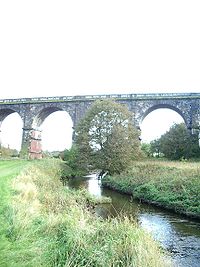
Sankey Viaduct
Encyclopedia

Viaduct
A viaduct is a bridge composed of several small spans. The term viaduct is derived from the Latin via for road and ducere to lead something. However, the Ancient Romans did not use that term per se; it is a modern derivation from an analogy with aqueduct. Like the Roman aqueducts, many early...
at Bradley Lane, Collins Green, Burtonwood
Burtonwood
Burtonwood and Westbrook is a civil parish in the outermost suburbs of Warrington in Cheshire, England. Historically within Lancashire, the name Burtonwood is known worldwide as the location of the former RAF Station Burtonwood military camp. Burtonwood village itself is a few miles away from the...
parish, Warrington
Warrington
Warrington is a town, borough and unitary authority area of Cheshire, England. It stands on the banks of the River Mersey, which is tidal to the west of the weir at Howley. It lies 16 miles east of Liverpool, 19 miles west of Manchester and 8 miles south of St Helens...
Borough, crossing the Sankey Brook into Earlestown
Earlestown
Earlestown forms the western part of Newton-le-Willows, a town in the Metropolitan Borough of St Helens, in Merseyside, England. At the 2001 Census the population was recorded as 10,274.-History:...
, Newton le Willows, Metropolitan Borough of St Helens
Metropolitan Borough of St Helens
The Metropolitan Borough of St Helens is a metropolitan borough of Merseyside, in North West England. It is named after its largest town St Helens, and covers an area which includes the settlements of Newton-le-Willows, Earlestown, Haydock, Rainhill, Eccleston, Clock Face, Billinge and...
, Merseyside
Merseyside
Merseyside is a metropolitan county in North West England, with a population of 1,365,900. It encompasses the metropolitan area centred on both banks of the lower reaches of the Mersey Estuary, and comprises five metropolitan boroughs: Knowsley, St Helens, Sefton, Wirral, and the city of Liverpool...
.
History
The viaduct was built between 1828 and 1830 by George StephensonGeorge Stephenson
George Stephenson was an English civil engineer and mechanical engineer who built the first public railway line in the world to use steam locomotives...
for the Liverpool and Manchester Railway Company to enable the railway to cross the line of the Sankey Canal with sufficient clearance for the Mersey flats, the sailing vessels for which the canal was constructed. It has been designated by English Heritage
English Heritage
English Heritage . is an executive non-departmental public body of the British Government sponsored by the Department for Culture, Media and Sport...
as a Grade I listed building and is the earliest major railway viaduct in the world.
The canal itself was filled with household rubbish in the 1970s.
Construction
The viaduct is constructed from yellow and ginger sandstoneSandstone
Sandstone is a sedimentary rock composed mainly of sand-sized minerals or rock grains.Most sandstone is composed of quartz and/or feldspar because these are the most common minerals in the Earth's crust. Like sand, sandstone may be any colour, but the most common colours are tan, brown, yellow,...
and red brick, of 9 round-arched spandrels on sharply-battered piers and known locally as The Nine Arches.
Significance
As the Sankey CanalSankey Canal
The Sankey Canal, which is also known as the Sankey Brook Navigation and the St Helens Canal, is a canal in Cheshire, extending into Merseyside, in the northwest of England, connecting St Helens with the River Mersey...
was the first canal of the Industrial Revolution, its crossing by the first purpose-built passenger railway in the world by means of this viaduct makes this a site of great significance in transport history.

